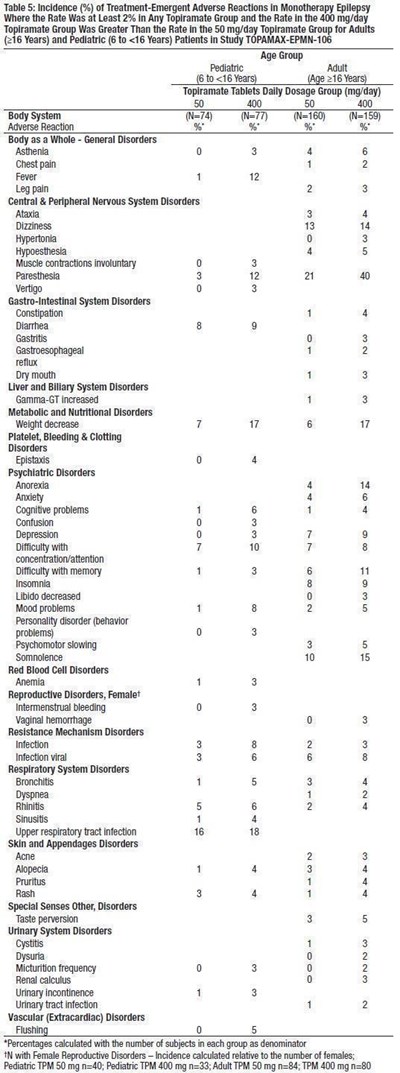Product Images Topiramate
View Photos of Packaging, Labels & Appearance
Product Label Images
The following 14 images provide visual information about the product associated with Topiramate NDC 50436-9950 by Unit Dose Services, such as packaging, labeling, and the appearance of the drug itself. This resource could be helpful for medical professionals, pharmacists, and patients seeking to verify medication information and ensure they have the correct product.
Label Image - lbl504369950

This is a warning label for Topiramate tablets, with 50mg strength and 60 tablets in the package. The NDC code is provided for identification while the expiration date and lot number are also indicated. The last line of the label may contain a garbled text or non-readable characters.*
TBL1 - table1

This is a table showing the Monotherapy Titration Schedule for adults and pediatric patients who are at least 10 years old. It includes morning and evening doses to be taken on a weekly basis, starting at 25mg and gradually increasing to 200mg over 6 weeks.*
tbl13 - table13

The text provides a table with the summary of the topiramate dose during the stabilization periods of six double-blind, placebo-controlled, add-on trials in adults with partial onset seizures. The table shows the target topiramate dosages (mg/day) in each protocol along with the mean and median dose for each dosage level. Additionally, it mentions that dose-response studies were not conducted for other indications or pediatric partial onset seizures. The placebo dosages are given in terms of the number of tablets corresponding to each protocol.*
tbl14 - table14

This is a table presenting efficacy results from double-blind, placebo-controlled, add-on epilepsy trials with varying dosages of topiramate ranging from 200mg/day to 1000mg/day. The trials involved patients with partial onset seizures and primary generalized tonic-clonic seizures. The percentage of responders and median reduction in seizure activity is reported for each trial. The study also includes pediatric patients with Lennox-Gastaut syndrome, and reports on the improvement in seizure severity. Additionally, the target dosages for some of the protocols were assigned based on the patient's weight to approximate a dosage of 6 mg/kg per day.*
TBL2 - table2

This is a table with information regarding the recommended total daily maintenance dosing of medication for patients aged 2 to under 10 years who are undergoing monotherapy. The dosages are determined based on the patient's weight, with a minimum and maximum maintenance dose specified for each weight range. Dosages are administered equally divided in two doses per day.*
tbl4 - table4

This is a table presenting the relative risk and incidence of events in patients with epilepsy, psychiatric conditions and other indications who were treated with antiepileptic drugs compared to placebo. The table shows that patients with epilepsy have a higher risk of events than placebo, as indicated by a relative risk of 1.35 and a higher incidence of events per 1000 patients. Patients with psychiatric conditions also have a higher risk of events with antiepileptic drugs. In contrast, patients with other indications do not seem to have a significantly increased risk of events.*
tbl5 - table5

This is a table showing the incidence of treatment-emergent adverse reactions in monotherapy epilepsy patients treated with Topiramate (50mg/day and 400mg/day) in both pediatric and adult age groups in study TOPAMAX-EPMN-106. The adverse reactions are categorized by body system and the percentage is calculated with the number of subjects in each group as the denominator. Adverse reactions with a rate of at least 2% in any Topiramate group and the rate in the 400 mg/day being greater than in the 50 mg/day group are included. Adverse reactions include asthenia, chest pain, fever, ataxia, dizziness, constipation, diarrhea, weight decrease, insomnia, somnolence, respiratory system disorders, acne, alopecia, and urinary tract infection, among others. The incidence of adverse reactions is also calculated in relation to the number of females.*
tbl6 - table6

This text appears to be a table showing the dosage of Topiramate Tablets and the adverse reactions reported by patients during clinical trials. The table maps the dosage with the percentage of patients experiencing each of the listed adverse reactions, which include fatigue, dizziness, speech disorders, nausea, and depression, among others. The data also shows the patients receiving additional antiepileptic drugs.*
tbl7 - table7

This is a table showing the incidence of treatment-emergent adverse reactions in a study with patients receiving topiramate tablets dosage of 200 mg/day and placebo. The table lists various body system/general disorders and their corresponding adverse reactions, along with the number of patients who reported them. The adverse reactions with an incidence rate of at least 2% in the topiramate group and higher than the placebo group are listed. The study included patients who were receiving 1 to 2 concomitant antiepileptic drugs in addition to topiramate or placebo.*
tbl8 - table8

The table displays the incidence of dose-related adverse reactions recorded during placebo-controlled, add-on trials in adults with partial onset seizures. The adverse reactions are mentioned for different dosages of Topiramate. The adverse reactions include Fatigue, Nervousness, Difficulty with Concentration/Attention, Confusion, Depression, Anorexia, Language Problems, Anxiety, Mood problems, and Weight decrease. Dose-response studies were not conducted for other adult medications or for pediatric drugs.*
tbl9 - table9

This is a table showing the incidence of treatment-emergent adverse reactions in pediatric patients (ages 2-16 years) with epilepsy in placebo-controlled, add-on trials. The reactions that occurred in at least 1% of topiramate-treated patients and occurred more frequently in topiramate-treated than placebo-treated patients are listed in different body systems. The table also includes the percentage of patients reporting a given adverse reaction, and it is noted that patients may have reported more than one adverse reaction during the study and can be included in more than one adverse reaction category.*
* The product label images have been analyzed using a combination of traditional computing and machine learning techniques. It should be noted that the descriptions provided may not be entirely accurate as they are experimental in nature. Use the information in this page at your own discretion and risk.


